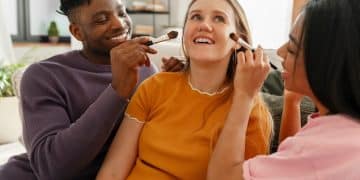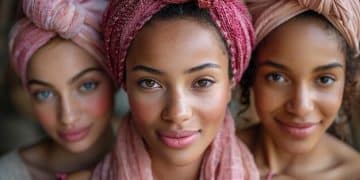The Ultimate Guide to Choosing the Right Lipstick Shade for Your Skin Tone
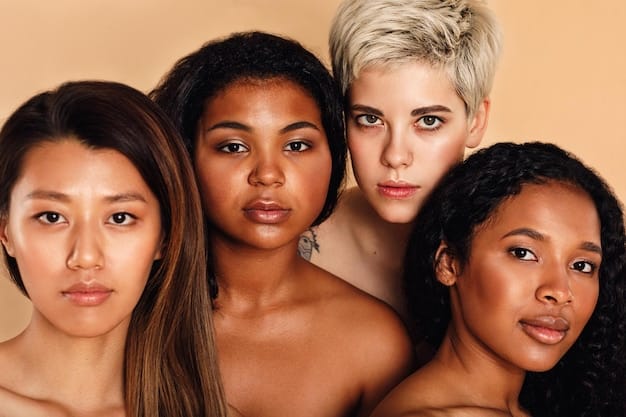
Anúncios
Navigating the intricate world of lipsticks to find that perfect shade involves understanding your unique skin tone, a foundational step that transcends fleeting trends to ensure a harmonious and flattering appearance.
Embarking on the quest to discover your ideal lip color can often feel like navigating a complex maze. Thankfully, mastering the ultimate guide to choosing the right lipstick shade for your skin tone simplifies this artistic endeavor, transforming guesswork into informed decisions that illuminate your natural beauty.
Understanding Your Skin Tone: The Foundation of Flawless Lips
Before diving into the vibrant spectrum of lipstick colors, it is crucial to establish a firm understanding of your own skin tone. This goes beyond simply identifying yourself as “fair” or “dark.” True comprehension involves determining your undertone, which subtly influences how colors appear on your skin.
Your skin tone, the surface color, can be broadly categorized, but it’s your undertone—the color beneath the surface—that truly dictates which shades will complement you most effectively. Misinterpreting your undertone can lead to lip colors that clash, making your skin look sallow or washed out, rather than vibrant and harmonious.
Identifying Your Undertone
The undertone is often the missing piece in the puzzle of cosmetic choices. There are three primary undertones: warm, cool, and neutral. Recognizing yours is a game-changer for finding not just the right lipstick, but also the best foundation and blush.
A simple yet effective method involves observing the veins on your wrist under natural light. This quick assessment provides immediate clues without requiring specialized tools or complex procedures.
- Cool Undertones: If your veins appear blue or purple, you likely have cool undertones. Your skin may also have a pink or rosy tint.
- Warm Undertones: If your veins appear green or olive, you probably have warm undertones. Your skin might exhibit a golden or peachy glow.
- Neutral Undertones: If you find it difficult to discern whether your veins are blue or green, or if they appear a mix of both, you may have a neutral undertone. Your skin might also show a balance of pink and golden tones.
Another helpful test is the “jewelry test.” Consider whether gold or silver jewelry looks more flattering against your skin. This subjective yet telling method can further solidify your undertone identification, guiding your color choices in makeup and even clothing.
Individuals with cool undertones typically find that silver jewelry enhances their complexion, making them appear more radiant. Conversely, those with warm undertones often discover that gold jewelry brings out a natural warmth and glow in their skin.
Considering Your Overall Complexion
While undertones are paramount, your overall complexion—fair, light, medium, olive, or deep—still plays a significant role. It affects the intensity and vibrancy of lipstick shades on your lips. A color that looks subtle on deep skin might appear strikingly bold on fair skin.
Always consider how light or dark your actual skin tone is, as this will influence saturation and depth of color. For instance, a bright fuchsia might be playful on medium skin but overwhelmingly vibrant on very fair skin.
Therefore, understanding your undertone is the crucial first step, followed by considering the general lightness or darkness of your skin for ultimate shade selection.
Lipstick Shades for Cool Undertones: A Harmonious Palette
For those with cool undertones, the selection of lipstick shades should lean towards cool-toned colors that complement the natural pink or blue hues within their skin. These shades evoke a fresh, chic, and sophisticated appeal, enhancing facial features.
Choosing the right cool-toned lipstick can brighten your complexion, make your teeth appear whiter, and create a cohesive look that feels naturally beautiful. It’s about working with your skin’s innate characteristics, not against them.
Pinks and Berries
Cool-toned pinks and berry shades are often a perfect match for individuals with cool undertones. These colors range from soft mauves to deep plums, offering versatility from subtle daytime wear to dramatic evening looks.
Look for pinks with a blue or purple base, as these will harmonize beautifully with your skin. Avoid peachy or orange-based pinks, which can clash and make your skin appear sallow. The right pink can instantly invigorate your face.
- Soft Rose: A delicate, muted pink with a hint of blue, ideal for an everyday, natural look.
- Raspberry: A vibrant, rich pink-red with a cool base, perfect for adding a pop of color.
- Plum/Berry: Deep, sophisticated shades ranging from deep fuchsia to almost black cherry, excellent for evening wear.
These shades are particularly effective because they pick up on the cool tones in your skin, creating a seamless and alluring finish. Experiment with different intensities to find your preferred level of impact, from sheer to fully opaque.
Reds with Blue Bases
When selecting red lipsticks, individuals with cool undertones should gravitate towards reds with a distinct blue base. These reds, often described as “true reds” or “cherry reds,” are incredibly flattering and timeless.
Blue-based reds can make your teeth appear whiter and add a classic elegance to your look. Avoid orange or brick reds, which will pull out yellow tones in your skin, making you appear washed out or sallow. The classic Hollywood red is typically a blue-based shade.
Even if you’re hesitant about bold reds, there are cooler red options that offer a more subtle, yet equally captivating, effect. Think of cranberry or wine-colored reds for a sophisticated, deep look.
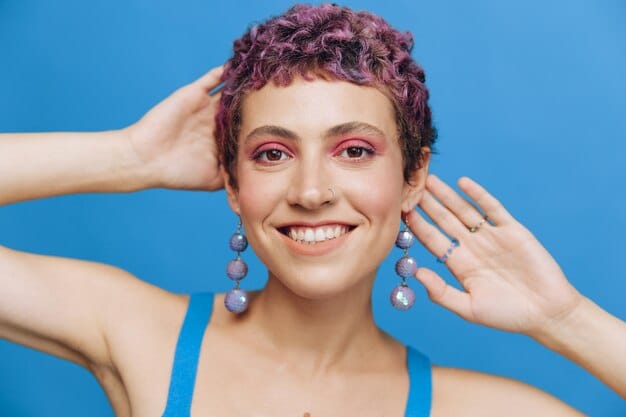
Nudes and Neutrals for Cool Undertones
Finding the perfect nude lipstick for cool undertones requires careful attention. The goal is to choose a nude with a pink, mauve, or beige base that won’t wash out your complexion.
Avoid nudes with strong yellow or orange undertones, as these can make your skin look dull. Instead, seek out those that complement the rosy aspects of your skin, providing a natural yet polished appearance. A good cool-nude should look like an enhancement rather than a stark contrast.
Consider shades that are slightly deeper than your skin tone but still within the neutral family. A nude that is too light or too beige can look chalky on cool skin. Experimentation is key to finding that perfect “my lips but better” shade.
Lipstick Shades for Warm Undertones: Embracing Golden Hues
If your skin boasts warm undertones, characterized by golden, peachy, or yellow tints, your ideal lipstick shades will resonate with similar warmth. Colors with orange, coral, or warm red bases will beautifully complement your complexion, enhancing its natural glow.
These warm-toned lipsticks often bring out the richness in your skin, making you appear vibrant and healthy. They can also create a harmonious balance, preventing the skin from looking muted or unbalanced.
Corals and Peaches
Coral and peach shades are particularly complementary for those with warm undertones. These colors embody a lively vibrancy that perfectly matches the natural warmth in your skin, offering a fresh and cheerful aesthetic.
Look for shades that incorporate orange or golden tones, from soft peach to bright mandarin. These colors will add a healthy flush to your complexion and make your skin appear radiant. Avoid overly pink or blue-based corals, which can look jarring.
- Soft Peach: A subtle, warm nude-peach that provides a natural, understated look.
- Vivid Coral: A bright, energetic mix of orange and pink, perfect for a playful statement.
- Terracotta: A grounded, earthy peach with a brownish undertone, ideal for a sophisticated, warm look.
These hues are particularly lovely for spring and summer, but their warmth can also brighten up colder months. They seamlessly blend with warm skin, creating a cohesive and inviting look that exudes natural vitality.
Red with Orange or Gold Bases
When it comes to reds, individuals with warm undertones shine in shades that have an orange or golden base. These “true orange-reds” or “brick reds” enhance the skin’s natural glow, producing a striking yet harmonious effect.
Such reds provide a bold, confident statement that feels perfectly at home on warm complexions. They draw attention to the lips without overwhelming the face, making them a superb choice for various occasions. Avoid blue-based reds, which can appear too stark or clashing.
Consider richer, deeper reds that still maintain a warm undertone. Think of shades like chili red or rust, which offer depth and sophistication while complementing your skin’s natural warmth. The right warm red is an instant confidence booster.
Nudes and Neutrals for Warm Undertones
Choosing the ideal nude lipstick for warm undertones involves selecting shades with beige, peachy, or golden undertones. These nudes will melt seamlessly into your skin, providing a natural, polished look without washing you out.
Steer clear of nudes with strong pink or grey bases, which can make your skin appear dull or lifeless. Instead, opt for those that echo the warm tones in your complexion, creating a soft, enhancing effect that looks effortlessly chic.
A range of options exists, from light, creamy beiges to deeper, caramel-infused shades. The key is to find a nude that complements your lips and skin tone, creating a “your lips but better” appearance that perfectly blends in.
Lipstick Shades for Neutral Undertones: The Best of Both Worlds
Lucky enough to possess neutral undertones? This means your skin has a balanced mix of both warm and cool tones, allowing you to beautifully wear a wider array of lipstick shades. This versatility makes makeup selection an exciting and less restrictive experience.
With neutral undertones, you have the unique ability to pull off shades from both warm and cool families, as long as they aren’t overly saturated in one direction. It’s about finding that sweet spot that complements your balanced complexion.
Versatile Pinks and Berries
For neutral undertones, pinks and berries that strike a balance between warm and cool are ideal. These could be rose shades that aren’t too blue or too orange, or berry hues that blend both red and purple elements.
You can experiment with both cool-toned mauves and warm peachy-pinks, often finding that both categories can be flattering. The trick is to avoid extremes; highly saturated colors that lean too far into one undertone might stand out rather than blend harmoniously.
- True Rose Pink: A balanced pink that doesn’t lean too warm or too cool, perfect for everyday wear.
- Dusty Rose: A sophisticated, muted pink with slight beige undertones, offering elegance.
- Balanced Berries: Shades like cranberry or muted plum that have a mix of red and blue, suitable for various occasions.
This flexibility allows for a playful approach to makeup. You can choose a shade based on your mood or the occasion, knowing that a broad spectrum of pink and berry hues will likely flatter your complexion effortlessly.
Classic and Balanced Reds
Neutral undertones are fortunate enough to wear many red shades with ease. Both blue-based and orange-based reds can work, provided they don’t strongly emphasize one undertone over the other. The classic “true red” is often a perfect fit.
A true red, with no discernible orange or blue bias, will often look stunning on neutral skin. These versatile reds are timeless and universally flattering on most neutral complexions, making them an excellent go-to for a statement lip.
Experiment with different finishes—matte, satin, or glossy—to see how they impact the overall look. A neutral undertone also permits exploring deeper, richer reds like burgundy or maroons, offering sophisticated options for evening wear.
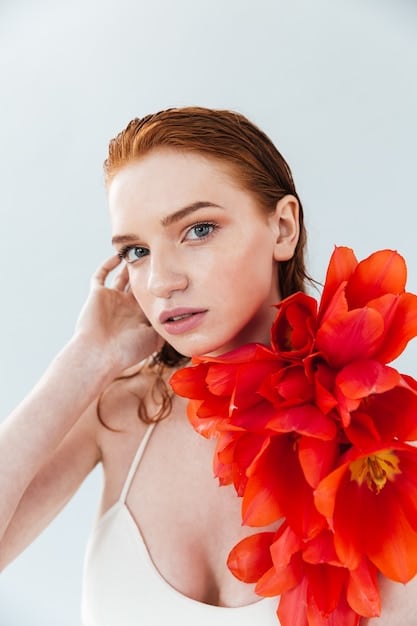
Nudes and Neutrals for Neutral Undertones
Finding the right nude for neutral undertones is arguably the easiest, as a broad range of neutral-leaning shades will work. The best nudes will have a balanced mix of pink, peach, and beige, providing a seamless extension of your skin tone.
Avoid nudes that are too stark or chalky, or those with an extreme grey shift, as these can flatten your complexion rather than enhance it. Look for shades that are “your lips but better,” subtly enhancing rather than dramatically altering.
Consider nudes with a hint of gold or a touch of rose. These undertones will subtly pick up on the balanced nature of your skin, resulting in a naturally beautiful and sophisticated finish. The ideal nude should enhance your natural lip color without clashing.
Beyond Undertones: Factors to Consider for the Perfect Match
While undertones are the cornerstone of choosing the right lipstick shade, several other factors contribute to finding your perfect match. These elements can significantly impact how a color appears on your lips and interacts with your overall look, sometimes even more so than your skin tone alone.
Considering these additional aspects ensures a more holistic approach to lipstick selection, moving beyond a simple color match to a comprehensive understanding of what truly flatters you. It’s about combining science with personal preference and context.
Lipstick Finish and Formula
The finish of a lipstick—matte, satin, cream, glossy, or sheer—plays a significant role in how it looks and feels. Each finish offers a different effect and performs uniquely, influencing durability, comfort, and visual impact.
Matte finishes are highly pigmented and long-lasting but can sometimes feel drying. They provide a bold, sophisticated look. Satin and cream finishes offer a balance of color and moisture, giving a soft sheen and comfortable wear. Glossy and sheer formulas add hydration and a hint of color, creating a dewy, youthful appearance.
- Matte: Best for bold statements and longevity; can make lips appear smaller.
- Satin/Cream: Versatile and comfortable; offers a natural sheen and good color payoff.
- Glossy/Sheer: Adds volume and a youthful glow; less pigment but offers a fresh look.
Consider your personal preference for feel and your desired visual outcome. A shade that looks stunning in a matte finish might appear entirely different in a glossy formula. Experimenting with various finishes for the same color family can yield surprising results.
Hair Color and Eye Color
Your hair and eye color can subtly influence which lipstick shades look most harmonious. While less critical than skin undertone, they contribute to your overall coloring and can either be enhanced or overshadowed by your lip choice.
For example, individuals with dark hair and light eyes might pull off bolder, deeper shades more easily, while those with lighter hair and eyes might prefer softer, more ethereal colors. It’s about creating a balanced picture where no single feature dominates excessively.
A strong contrast can be dramatic, but sometimes a harmonious blend is preferable. Consider whether your lipstick works with your entire face, not just your lips in isolation. Some colors might clash, while others will beautifully complement your natural features.
Occasion and Personal Preference
Finally, the occasion and your personal preference are paramount. While guidelines are helpful, makeup is ultimately a form of self-expression. A bold red might be perfect for a formal event, while a subtle nude is ideal for a casual daytime outing.
Don’t be afraid to break “rules” if a certain shade makes you feel confident and beautiful. Trends come and go, but personal style endures. Your comfort and confidence in a lipstick shade are arguably the most important factors.
Experimentation is key, and embracing different shades for different moods or events can be incredibly rewarding. The best lipstick shade is ultimately the one that makes you feel your best, regardless of what any guide suggests.
Application Techniques for Optimal Results
Beyond choosing the perfect shade, the way you apply lipstick significantly impacts its look, longevity, and overall effect. Proper application techniques can transform a good lipstick into a great one, ensuring it lasts longer and appears more polished.
From prepping your lips to the final touches, each step contributes to a flawless finish. Mastering these techniques will elevate your lipstick game, allowing your chosen shade to truly shine.
Prepping Your Lips
Healthy, smooth lips are the best canvas for any lipstick. Neglecting lip preparation can lead to flaky patches, uneven application, and a less vibrant color payoff. Proper hydration and exfoliation are crucial steps often overlooked.
Begin by gently exfoliating your lips to remove any dry, flaky skin. This can be done with a dedicated lip scrub or a soft toothbrush. Exfoliation ensures a smooth surface, allowing the lipstick to glide on evenly and cling better to your lips.
- Exfoliate: Use a lip scrub or a damp washcloth to gently buff away dead skin.
- Hydrate: Apply a nourishing lip balm and let it sink in for a few minutes before applying color. Blot off any excess to avoid a slippery base.
- Prime (Optional): A lip primer can create a smooth base, prevent feathering, and extend wear time, especially for matte or dark shades.
These initial steps are essential for ensuring your lipstick not only looks its best but also feels comfortable throughout the day. A well-prepped lip allows the true beauty of your chosen shade to come through without distraction.
Lining and Filling
Lip liner is an underrated tool that can dramatically improve your lipstick application. It defines the lip shape, prevents feathering, and can even prolong the wear of your lipstick. Choosing the right liner shade is as important as the lipstick itself.
Select a lip liner that matches your lipstick shade or is one shade lighter. Start by outlining your natural lip line, then gently fill in your entire lip with the liner. This creates a base for the lipstick, enhancing its longevity and intensity.
Filling in your lips with liner also helps the lipstick adhere better, reducing the need for frequent reapplication. It creates a seamless transition from the liner to the lipstick, eliminating harsh lines and promoting a more natural blend.
Applying the Lipstick
Whether you prefer applying directly from the bullet, using a brush, or even your finger, technique matters. For precise application and full coverage, a lip brush offers the most control, especially for darker or more vibrant shades.
Apply the lipstick evenly, starting from the center of your lips and moving outwards. Blot with a tissue after the first coat, then apply a second coat for increased intensity and longevity. This blotting technique helps remove excess product, allowing the remaining color to set better.
For a softer, more diffused look, you can dab the lipstick onto your lips with your finger, gently pressing and blending the color. This creates a stained effect, perfect for a subtle wash of color without the full intensity of a direct application.
Longevity and Maintenance Tips for Your Lipstick
Once you’ve chosen your perfect shade and applied it flawlessly, the next challenge is ensuring it lasts as long as possible. Various factors can affect lipstick longevity, from eating and drinking to environmental conditions. Luckily, several tips can help maintain your lip look throughout the day.
These maintenance strategies are designed to keep your lipstick looking fresh and vibrant, minimizing the need for constant touch-ups. Incorporating these habits into your routine will help your chosen shade stay put, no matter what your day throws at you.
Setting Your Lipstick
Setting your lipstick is a crucial step for extending its wear time, especially for cream or satin formulas that might be prone to transfer. This technique helps lock the color in place, preventing smudging and feathering.
After applying your lipstick, place a thin tissue over your lips. Then, lightly dust a translucent setting powder through the tissue onto your lips using a fluffy brush. The tissue acts as a barrier, allowing just enough powder to set the color without dulling it significantly.
- Tissue Blot: Blot your lips gently with a tissue after the first coat to remove excess oil.
- Powder Set: Place a thin tissue over your lips and lightly dust translucent powder through it.
- Second Coat: Apply a final second coat of lipstick after powdering for enhanced color and longevity.
This method significantly reduces transfer and increases the staying power of most lipstick formulas. It’s a simple trick that professional makeup artists often use to ensure lipstick lasts through long events and photo shoots.
Touch-Up Strategies
Even with the best setting techniques, some touch-ups may be necessary throughout the day, especially after meals. The key is to touch up strategically, ensuring your lipstick continues to look fresh, not caked on.
Instead of reapplying a full coat immediately, assess where the color has faded, typically the inner part of the lips. Use your finger or a small brush to gently dab more lipstick onto those areas, blending it with the existing color. This minimizes build-up and maintains a smoother finish.
Carrying your chosen lipstick with you is essential for convenient touch-ups. If your lips feel dry, blot them lightly with a tissue before reapplying, or if necessary, dab a tiny bit of lip balm on first, then blot again before applying more lipstick. This prevents creasing and ensures an even application.
By following these tips, you can enjoy your chosen lipstick shade for hours, maintaining a polished and vibrant look with minimal effort. It’s all about working smarter, not harder, to keep your lips looking fabulous.
| Key Point | Brief Description |
|---|---|
| 🎨 Understand Undertone | Crucial for harmonious lipstick choices; cool (blue/pink), warm (green/gold), neutral (mix). |
| 🌈 Match to Skin Tone | Cool tones: blue-based reds, pinks, berries. Warm tones: orange/gold-based reds, corals, peaches. Neutral tones: versatile. |
| 💄 Application & Care | Prep lips (exfoliate/hydrate), use liner, apply evenly, and set with powder for longevity. |
| ✨ Beyond Color | Consider lipstick finish, hair/eye color, occasion, and personal preference for best results. |
Frequently Asked Questions About Choosing Lipstick Shades
To determine your undertone, check the veins on your wrist under natural light. Blue or purple veins indicate cool undertones, green or olive veins suggest warm undertones, and a mix or difficulty discerning indicates neutral undertones. This helps guide your lipstick color choices for a harmonious look.
For cool skin tones, opt for lipsticks with blue or purple bases. Excellent choices include blue-based reds (like cherry red), cool pinks (such as fuschia or raspberry), and berry shades (like plum or cranberry). These colors will complement your natural cool complexion and brighten your face.
Warm skin tones are best complemented by lipsticks with orange or golden bases. Look for orange-reds (like brick red), corals, peachy nudes, and warm brown shades. These colors will enhance your skin’s natural golden or olive glow, making you look radiant.
Individuals with neutral undertones have the flexibility to wear a wide range of lipstick shades. While you can experiment with both warm and cool-toned colors, opt for shades that are not excessively saturated in one direction. Balanced reds, true rose pinks, and versatile nudes often work best, allowing for great versatility.
To extend lipstick wear, exfoliate and hydrate your lips first. Use a lip liner to outline and fill in your entire lip. After applying the first coat of lipstick, blot with a tissue, then lightly dust translucent powder over the tissue onto your lips before applying a second coat. This sets the color.
Conclusion
Choosing the right lipstick shade is a transformative journey that extends beyond fleeting trends, rooted deeply in understanding your unique skin tone and personal preferences. By identifying your undertone—whether cool, warm, or neutral—you unlock a world of colors that genuinely enhance your natural beauty. Remember that while guidelines provide a valuable starting point, the most flattering lipstick is ultimately the one that makes you feel confident, empowered, and truly radiant. Embrace exploration, practice proper application, and let your lips speak volumes with a shade that perfectly complements you.

